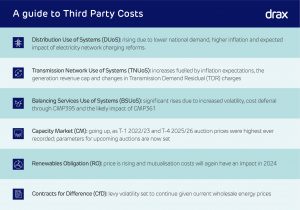Business Energy: Third Party Costs at an all-time high
Paul Miller, Sales Director at renewable energy company Drax says “Wholesale energy prices have risen significantly over the past year, but that’s not the only thing pushing up business energy bills. Third Party Costs (TPCs) – which typically make up 60% of a business’ total energy charges but are currently sitting at around 40% – are at their highest ever point. Despite the 20% decrease, their impact on a business’ overall energy costs is still substantial, which means the slightest change will have a big impact.

The latest Third Party Costs Guide from Drax shows that high inflation, regulatory changes and a volatile energy market are among the factors contributing to the rise in underlying charges for TPCs.
Below we provide a snapshot the key trends to help businesses better understand these changes.
- Distribution Use of Systems (DUoS) – rising due to lower national demand, higher inflation, and the expected impact of electricity network charging reforms
- Transmission Network Use of Systems (TNUoS) – increases fuelled by inflation, the generation revenue cap, and changes in Transmission Demand Residual (TDR) charges
- Balancing Services Use of Systems (BSUoS) – significant rises due to volatility, cost deferral through CMP395 and the likely impact of CMP361
- Capacity Market (CM) – increasing at T-1 2022/23 and T-4 2025.26 auction prices were their highest ever recorded; parameters for upcoming auctions are now set
- Renewables Obligation (OB) – price is rising, and mutualisation costs will again have an impact in 2024
- Contracts for Difference (CfD) – levy volatility set to continue given current wholesale prices
The past few years have thrown up a series of unprecedented events that have led to extreme volatility within the energy market. As a result, organisations have had to manage rocketing energy bills. Through our consultancy services, we’re committed to supporting organisations and helping them to forecast for these costs within their energy budget.



